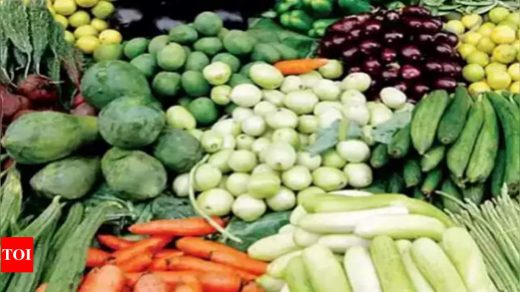Fruits and vegetables are an essential part of a nutritious diet. They contain vitamins, minerals, fiber, and other nutrients.
Although they both make up the basis of a nutritious diet, fruits and vegetables have classifications based on their botanical structure. The fruits people eat are the seed-bearing structure in flowering plants, while vegetables consist of edible plant stems, leaves, and other plant components.
The Department of Agriculture recommends adults consume 1.5 to 2.5 cups of fruit per day.
In addition to fruit, they should aim to eat 2 to 4 cups of vegetables. These recommendations vary depending on a person’s age, weight, and sex.
According to a 2015 study, most adults in the United States do not consume enough produce.
The survey showed that just 12.2% met the daily fruit intake, while 9.3% met the daily vegetable intake. Access is likely an issue, as only 7% of adults near or below the poverty level reported they ate the required amount of vegetables per day.
Read more to learn about the differences between fruits and vegetables, the health benefits of both, and affordable ways to consume more fruits and vegetables.
Fruits and vegetables comprise different parts of the plants from which they grow.
Fruits come from the flowering part of a plant and contain seeds. In contrast, vegetables are the edible parts of a plant, such as the leaves, stem, roots, and bulbs.
People often associate fruits with sweetness and vegetables with a savory taste. Although this is often true, botanists classify some savory produce as fruits, such as tomatoes.
Savory fruits and sweet vegetables sometimes cause confusion as to their classification. Additionally, botanists and culinary experts disagree on the classification of some fruits and vegetables, further complicating the matter.
Botanists classify fruits and vegetables based on the part of the plant that they originate. However, chefs use flavor profiles, such as sweet or savory, to decide whether something is a vegetable or a fruit.
Below are some fruits and vegetables that fit into two different categories and that people often mix up.
While the tomato is technically a fruit –– according to botanists –– many consider it a vegetable due to its savory flavor.
FoodData Central (FDC), the U.S. government’s central nutrient database, classifies tomatoes as vegetables. However, a tomato grows from the plant’s flower and has seeds, making it a fruit.
According to the FDC, cucumbers are also vegetables.
However, cucumbers come from the flowers of the plants. They also have seeds throughout them, classifying them as fruit.
People may view rhubarb as a fruit due to its distinctive flavor and role in various baked goods.
Although the FDC also classifies it as a fruit, botanists disagree. The part of the rhubarb people eat is the stem, making it a vegetable, not a fruit.
Most people consider green beans to be vegetables, and the FDC agrees.
Regardless, green beans grow from the flower of their plant, and they contain beans, which are their seeds. This makes them a fruit.
Bell peppers have seeds inside and grow from the flower of the plant, making them a fruit. However, the FDC categorizes them as vegetables.
Regardless of their technical classification, fruits and vegetables are excellent sources of vitamins, minerals, and fiber.
Many experts say that when trying to follow a nutrient-dense diet, a person should aim to “eat the rainbow.” This is because colorful vegetables contain vital nutrients, and their different shades indicate different nutrient profiles. A diverse diet offers a range of vitamins and minerals, which helps people consume a nutritious diet.
For example, red and orange vegetables are high in antioxidants and carotenoids. Blue or purple vegetables are rich in anthocyanins, which have anti-inflammatory and antimicrobial properties. Meanwhile, dark, leafy greens are excellent sources of calcium, fiber, and carotenoids.
Fruits also contain various beneficial nutrients. For example, many citrus fruits –– such as oranges, grapefruits, and limes –– contain vitamin C, an antioxidant that helps the body’s tissues grow and repair themselves.
Both fruits and vegetables provide health benefits.
Humans need calcium for building and maintaining strong bones. It occurs naturally in broccoli and dark, leafy greens such as kale, bok choy, and collard greens. Oranges and dried figs also provide a substantial amount of the mineral.
Vitamin C plays an essential role in the body’s ability to heal damaged tissues.
Fruits high in this vitamin include:
Both fruits and vegetables are excellent sources of fiber. However, people need to consume produce in its complete state –– not in juice form –– to get the most fiber.
Fiber prevents blood sugar spikes by slowing the digestive process, and it also helps the digestive system function properly. Brocolli, squash, pears, and apples, among other produce, are all high in fiber.
According to a 2015 study, most adults in the U.S. do not consume enough produce. The research showed that the largest disparity in vegetable consumption was poverty. Although fruits and vegetables are a proven part of a nutritious diet, they remain expensive and inaccessible to many individuals.
People living in food deserts are at a significant disadvantage. These are areas where individuals have limited access to nutritious foods.
A nutritious diet can be difficult to achieve considering these barriers to access. However, the below strategies may help ease some of these challenges.
Some produce, such asparagus and berries, can be expensive. People looking to stretch their grocery budget can try buying more affordable options.
Although the least expensive produce varies depending on the location and season, some of the most affordable fruits and vegetables include:
Learn more about eating nutritious foods on a budget.
People living in the U.S. may be eligible for the Supplemental Nutrition Assistance Program (SNAP), a monthly benefit allowing individuals to buy fruits, vegetables, meat, bread, and more.
Low income, pregnant, nursing, or postpartum individuals (until their children are 5 years of age) are also eligible for the Special Supplemental Nutrition Program for Women, Infants, and Children (WIC). This provides them access to the nutritious foods that new mothers and young infants need.
Check the eligibility criteria for SNAP and WIC.
In addition to shopping in grocery stores, people can use their SNAP dollars at most farmer’s markets.
The Double Up Food Bucks program, which is currently active in 25 of the 50 states, helps individuals get more for their money at the farmer’s market. It matches every dollar a person spends, meaning they can get twice the produce for the same price.
Learn more about Double Up Food Bucks.
Although botanists classify fruits and vegetables by their structure and seeds, many individuals and chefs classify them by their taste. Regardless, both contain essential vitamins and minerals that are important for the body.
Some benefits of eating fruits and vegetables include promoting bone health, a functioning immune system, and proper digestion.
Most people in the U.S. do not eat enough fruits and vegetables, while those living at or below the poverty line consume even less. However, food assistance programs, such as SNAP and WIC, and shopping for affordable produce, can help individuals consume more nutritious diets.
Last medically reviewed on August 9, 2021
OUR BRANDS
Fruits vs. vegetables: List, nutrition, benefits, and more – Medical News Today





